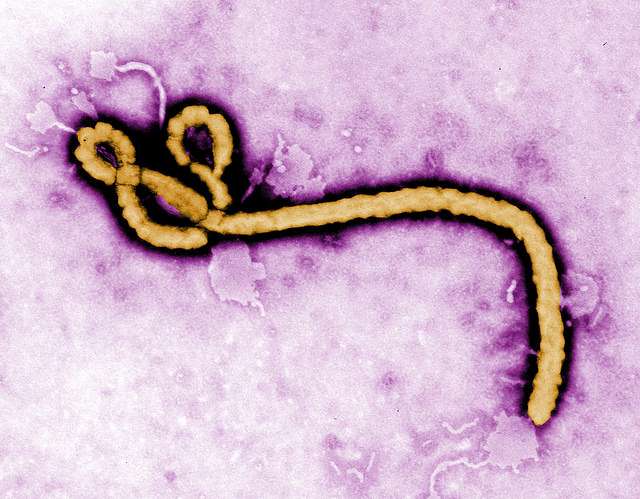FDA-approved drug protects mice from Ebola

The recent Ebola outbreak in West Africa has claimed more than 11,300 lives and starkly revealed the lack of effective options for treating or preventing the disease. Progress has been made on developing vaccines, but there is still a need for antiviral therapies to protect health care workers and local populations in the event of future outbreaks.
A new study led by University of Iowa virologist Wendy Maury, PhD, suggests that gamma interferon, which is an FDA-approved drug, may have potential as an antiviral therapy to prevent Ebola infection when given either before or after exposure to the virus.
The study, published in the journal PLOS Pathogens, found that gamma interferon, given up to 24 hours after exposure, can inhibit Ebola infection in mice and completely protect the animals from death.
Ebola infection appears to be a stepwise process. First, the virus targets and infects macrophages or dendritic cells, two types of immune system cells found in the liver, spleen, and lymph nodes. Ebola then replicates in those cells. Following this initial infection, which happens at day 3 or 4 in non-human primates, Ebola virus is released into the blood and infects a plethora of other different cell populations.
"It goes from an early stage with a very targeted infection of only these few cell types, to everything being infected," explains Maury, who is a professor of microbiology in the UI Carver College of Medicine. "We think what's happening with gamma interferon is that it's targeting macrophages and blocking the infection of those initial cell targets so you don't get the second round of infection."
The UI does not have a specializing BioSafety Level 4 (BSL4) lab that is required for experiment using Ebola virus, so Maury and her UI colleagues made their initial findings using a surrogate virus, which targets and infects the same cells as Ebola, but does not cause the disease. This Ebola lookalike - a sheep in wolf's clothing - consists of a less dangerous vesicular stomatitis virus (VSV) that expresses Ebola glycoproteins on its surface.
However, all of the results Maury's team found using the surrogate virus, were repeated using mouse-adapted Ebola virus in the BSL4 lab of Maury's long-time collaborator Robert Davey at Texas Biomedical Institute in San Antonio, Texas.
The team showed that gamma interferon inhibits the virus's ability to infect human and mouse macrophages, in part by blocking virus replication in the cells. The researchers then showed that pretreating mice with interferon gamma 24 hours before exposure protects the animals from infection and death. To their surprise, the researchers found that treatment up to 24 hours after what would have been a lethal exposure also completely protected the animals from death, and the scientists could no longer detect any Ebola virus in the mouse cells. These findings suggest that interferon gamma may be useful both as a prophylaxis and post-exposure treatment against Ebola.
The team still has to determine how late gamma interferon can be given to the mice and still prevent infection. However, the results suggest a window of time after exposure when gamma interferon may be an effective antiviral therapy
"My guess is that if you delay the gamma interferon too much, you miss this window of opportunity to block the infection in macrophage cells and the gamma interferon can no longer provide protection," Maury says.
Working with Martha Monick, PhD, now a UI professor emeritus in internal medicine, Maury and lead study author Bethany Rhein, PhD, investigated how gamma interferon might be helping the cells fight off Ebola virus. They identified that expression of more than 160 genes in human macrophages are stimulated by gamma interferon. Introduction of some of these genes into cells was sufficient to prevent Ebola infection.
"This mechanistic information might suggest more precise drug targets rather than the broad effects, including adverse side-effects, that are produced by gamma-interferon," Maury says.
Gamma interferon is approved by the FDA to treat Chronic Granulomatous Disease (an immune disease) and Severe Malignant Osteopetrosis.
In addition to moving the studies into larger animal models, Maury now plans to study the ability of gamma interferon to inhibit Ebola infection in conjunction with other developing antivirals.
"Right now there are no FDA-approved antiviral therapies for Ebola, but there are some being developed that target virus entry," she says. "We know that gamma interferon blocks replication but not entry into cells. So combining an entry inhibitor with gamma interferon may allow us to reduce amount of gamma interferon needed and target two different steps in the virus's life cycle, which has been shown in HIV to be critically important for controlling virus."
More information: Bethany A. Rhein et al. Interferon-γ Inhibits Ebola Virus Infection, PLOS Pathogens (2015). DOI: 10.1371/journal.ppat.1005263




















